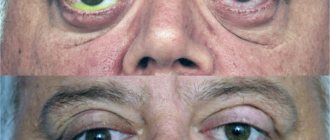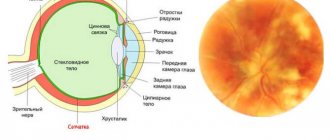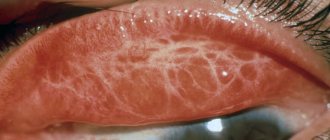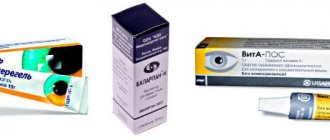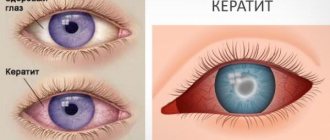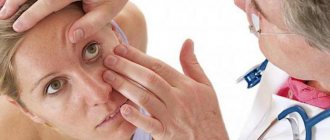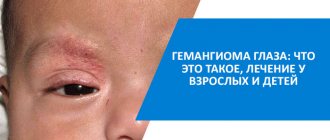- Types of disease
- Reasons for development
- Pathogenesis
- Manifestations
- Diagnostic methods
- Treatment Options
- Innovative treatment in Belgium
- Complications and prognosis
- Clinics for the treatment of Sjögren's syndrome in Belgium
Sjögren's syndrome (SS) is a chronic inflammatory autoimmune disease of unknown origin that affects the exocrine glands, especially the lacrimal and salivary glands.
Symptoms of dry mucous membranes and conjunctiva (sicca symptoms) are the most characteristic signs of this disease. But it can also manifest itself as multiple pathological changes in different organs and systems. Sjögren's syndrome is named after the Swedish ophthalmologist Henrik Sjögren (1899–1986). In 1929, he described a patient who complained of dry eyes, dry mouth, and joint pain. He noted that the combination of these symptoms could potentially be a separate disease, which he defined as "keratoconjunctivitis sicca." The disease was subsequently named after him.
The disease most often affects women, and the average age of onset is 50-60 years.
Because of the wide variety of signs and symptoms, patients with Sjögren's syndrome often see doctors from a variety of specialties, such as ophthalmologists, ENT doctors, or dentists. As a result, up to half of cases remain undiagnosed.
Forms of the disease and features of its course
There are two types of disease - primary and secondary.
Primary Sjögren's syndrome (pSS) occurs in the absence of other autoimmune diseases and is characterized primarily by keratoconjunctivitis sicca (dry eyes) and xerostomia (dry mouth), collectively called sicca syndrome. Most patients with pSS have two specific antibodies to the antigens Ro (SS-A) and La (SSB).
Secondary Sjogren's syndrome (SSS) occurs as part of other autoimmune diseases.
It may accompany:
- systemic lupus erythematosus 15–36%;
- rheumatoid arthritis - 20–32%;
- limited or progressive systemic sclerosis - 11–24%;
- multiple sclerosis, autoimmune hepatitis or thyroiditis - rare;
The term “secondary” does not describe the chronological sequence of manifestations. That is, the underlying disease can manifest itself for a long time only as Sjögren's syndrome with sicca symptoms and only later manifest itself in the form of its typical symptoms.
Causes of Sjögren's syndrome
The cause of Sjögren's syndrome is not yet entirely understood. The presence of activated salivary gland epithelial cells expressing major histocompatibility complex (MHC) class II molecules and the identification of inherited markers of susceptibility suggest that environmental or endogenous antigens trigger the inflammatory response in susceptible individuals.
Association with human leukocyte antigen
The frequency of the presence of the HLA-DR52 autoantigen in patients with primary SS is estimated at 87%, but it is also significantly increased in secondary Sjögren's syndrome.
Genetic associations for Sjögren's syndrome vary among ethnic groups. For example, in Europeans this condition is associated with human leukocyte antigens (HLA)-DR3, HLA-DQ2, HLA-B8, while in Hispanics it is associated with HLA-DR5.
Some evidence suggests that the true association of Sjögren's syndrome may be with HLA-DQA1, which is in linkage disequilibrium with HLA-DR3 and HLA-DR5.
Possible triggers of the disease
Viruses are considered good candidates for environmental triggers, although no proof of causation has yet been provided.
Damage or death of cells due to viral infection or other causes can trigger antigens to Toll-like receptors on dendritic or epithelial cells, which, when activated, begin to produce cytokines and chemokines.
Sex hormones
Sex hormones may influence the immunological manifestations of primary Sjögren's syndrome because the disease occurs much more often in women than in men. The prevalence of serological markers is generally lower in male patients than in female patients. Although the role of sex hormones (eg, estrogens, androgens) in the pathogenesis of primary SS remains unknown, deficiency of adrenal and gonadal steroid hormones likely affects immune function.
Pathogenesis
In people with a genetic predisposition, when exposed to an external or hormonal trigger, the regulation of immune activity in the epithelial cells of the glands is disrupted. As a result, chemokines and adhesion molecules (immune patterns) are released. This causes dendritic cells and lymphocytes (T cells and B cells) to migrate into the glands. Dendritic cells in the glands produce high levels of interferons (IFN), which causes further retention of lymphocytes in the tissues and their subsequent activation.
Interferons stimulate the production of B cell activating factor (BAFF) by epithelial cells, dendritic cells, and T cells.
BAFF promotes irregular maturation of B cells, resulting in the formation of autoimmune B cells that locally secrete autoantibodies that ultimately damage glandular cells.
When diagnosed with Sjögren's syndrome, the pathogenesis of nonglandular manifestations manifests itself in part as hypergammaglobulinemia and the production of multiple autoantibodies, especially ANA and RF. This is likely due to the activation of polyclonal B cells, but the exact cause of this enhanced activation is unknown.
Involvement of other organs and tissues may result from exposure to these antibodies, immune complexes, or lymphocytic infiltration and occurs in one third of patients with SS. Long-term hyperstimulation of B cells can lead to defects in their differentiation and maturation, which may explain the significantly increased incidence of lymphoma in these patients.
Symptoms
With a disease such as Sjögren's syndrome, the symptoms are very varied. Most patients are women, but it can also affect men and children. The beginning is insidious. The first signs of Sjögren's syndrome can be easily missed or misinterpreted, and as a result, a correct diagnosis may take several years to be made.
Symptoms of sicca (dry eyes and dry mouth)
Although dry eyes and dry mouth will be the most common symptoms in patients with Sjögren's syndrome, most patients reporting these symptoms have other underlying causes. The frequency of sicca symptoms increases with age. At the same time, more than a third of older people have sicca symptoms in one form or another. Whether this becomes part of the normal aging process (associated with fibrosis and atrophy observed in some lip biopsy studies) or is due to the accumulation of comorbidities is unclear.
Patients may describe the effects of dry mouth in different ways.
- Inability to eat dry foods (such as crackers) because they stick to the roof of the mouth.
- Tongue sticks to the roof of your mouth
- Difficulty speaking for long periods of time or developing hoarseness.
- Altered sense of taste.
Dry eyes can be described as red, itchy and painful. However, the most common complaint is a feeling of sand in the eyes. Symptoms usually worsen during the day, possibly due to evaporation of the already meager water layer.
Mumps
Mumps (inflammation of the parotid gland), often bilateral, is a common manifestation of Sjögren's syndrome. It usually has a recurrent course and rarely causes visible manifestations in the form of glandular tumors. Most often it is discovered by a doctor during an examination.
Skin symptoms
Nonvasculitic skin manifestations of Sjögren's syndrome include:
- dryness;
- dermatitis;
- itching;
- erythema.
Cutaneous vasculitis develops only in some patients with SS, especially those with hypergammaglobulinemia or cryoglobulinemia. Raynaud's phenomenon occurs in approximately 20% of patients.
Pulmonary symptoms
Patients with Sjögren's syndrome may develop dryness of the tracheobronchial mucosa (xerotrachea), which manifests itself as a dry cough. Less commonly, patients develop shortness of breath due to interstitial lung disease, which is usually mild.
Gastrointestinal symptoms
A dry throat or esophagus often leads to difficulty swallowing. In this case, patients usually talk about food getting stuck in the throat. Insufficient saliva can lead to impaired acid clearance, gastroesophageal reflux and esophagitis.
Rarely, patients develop acute or chronic pancreatitis or malabsorption due to pancreatic insufficiency. Patients with Sjögren's syndrome are at increased risk of delayed gastric emptying, which can cause early satiety, upper abdominal discomfort, nausea, and vomiting.
Heart symptoms
Pericarditis or pulmonary hypertension with accompanying symptoms are also characteristic of Sjögren's syndrome. Orthostatic symptoms, associated with impaired autonomic control of blood pressure and heart rate, are associated with increased severity of SS.
Neurological symptoms
According to various studies, the occurrence of central nervous system (CNS) damage in Sjögren's syndrome is 8-40%, with manifestations such as myelopathy, optic neuropathy, seizures, cognitive dysfunction, and encephalopathy. Attempts should be made to distinguish between other causes of these symptoms, including concomitant SLE, multiple sclerosis, cerebrovascular disease, or Alzheimer's disease.
Sensory, motor, or sensorimotor peripheral neuropathy, often subclinical, can be found in up to 55% of unselected patients with SS.
Kidney symptoms
Interstitial nephritis is the most common form of kidney damage in Sjögren's syndrome.
Interstitial cystitis with symptoms of dysuria, frequency, urgency, and nocturia is also common in SS.
Additional symptoms
Patients with Sjögren's syndrome may report fatigue, joint pain, and sometimes joint swelling. Careful analysis of the systems is necessary to distinguish them from manifestations of other disorders. Fibromyalgia is common in patients with SS, with an incidence of approximately 31%.
Women also experience vaginal dryness, which can lead to dyspareunia, vaginitis and itching.
Secondary Sjögren's syndrome
It is usually milder and sicca symptoms become dominant. Unlike patients with primary SS, those with the secondary type have significantly fewer systemic manifestations.
In secondary Sjögren's syndrome, the symptoms of the primary disease predominate. Secondary SS does not affect the prognosis or outcome of the underlying disease.
What it is?
Sjogren's syndrome is an autoimmune inflammatory pathology, manifested by signs of damage to the exocrine glands - lacrimal, salivary, sebaceous, sweat, digestive.
The syndrome was first described at the end of the 19th century by an ophthalmologist from Sweden, H. Sjögren, after whom it received its name. Sjogren observed patients who complained of dry eyes and mouth, as well as joint pain. After some time, scientists from related medical fields became interested in this disease.
Diagnosis of Sjögren's syndrome
Schirmer test
If Sjögren's syndrome is suspected, diagnosis using filter paper is often the first test. A filter paper test strip is placed near the lower conjunctival sac to measure tear production. Healthy people wet 15 mm or more of paper after 5 minutes. A positive test occurs when less than 5 mm of the strip is wet after 5 minutes.
Rheumatoid factor
RF is present in 52% of patients with primary Sjögren's syndrome and in 98% of patients with secondary disease occurring even in the absence of rheumatoid arthritis. The presence of RF was independently associated with an increased risk of lymphoma in patients with primary Sjögren's syndrome.
Antinuclear antibodies
Autoimmune ANA antibodies are usually present in all patients with Sjögren's syndrome.
Coloring
Rose Bengal is an aniline dye that stains epithelial surfaces with changes characteristic of this disease. Staining of the conjunctiva can be detected with the naked eye. Slit lamp examination is performed after rose bengal staining to detect abnormal uptake in the cornea.
Lissamine green staining works similarly but causes less eye irritation. Fluorescein staining can be used to identify corneal lesions.
Saliva testing
Sialometry is a good measure of the degree of reduction in salivary blood flow and helps identify xerostomia, but the results are not specific.
Treatment
The main approach to interdisciplinary care for patients with Sjögren's disease is:
- measures to improve quality of life;
- pharmacological as well as non-pharmacological treatment to control disease activity;
- managing the risk of developing lymphoma.
With a diagnosis such as Sjögren's syndrome, treatment must take into account the heterogeneity of the disease.
But most often, treatment comes down to combating the symptoms of dryness.
Moisturizing eye drops of the “artificial tear” class are used. Or, in a more advanced version, gels and gel films that prevent dryness. It is recommended to apply moisturizing creams and lotions to the outer skin.
If artificial tears do not help, medications are prescribed to enhance tear production:
- Cequa;
- Lacrisert;
- Restasis.
Lacrisert is a flat, tiny capsule. It is placed into the eye with a special applicator, usually once or twice a day. Cequa and Restasis come in the form of drops that are used twice daily.
To treat dry mouth, your doctor may prescribe medications that increase the amount of saliva, including:
- Cevimeline (Evoxac);
- supersaturated calcium phosphate (NeutraSal);
- Pilocarpine.
It is recommended to apply moisturizing creams and lotions to the outer skin.
For the treatment of arthralgia, NSAIDs are used - nimesulide, lernoxicam, ethacridic acid.
Prevention
To date, there is no specific prevention for Sjögren's syndrome. The only thing is that you can prevent frequent exacerbations of the disease and slow down its progression in the following ways:
- Constant use of medications prescribed by the attending physician.
- Carrying out measures to prevent the development of secondary infections.
- Limiting exposure to external factors that increase symptoms.
- Elimination of stressful situations.
- Stay away from sources of harmful radiation to the body.
- Daily sufficient air humidification in the living room.
Sjögren's syndrome is characterized by frequent alternation between periods of remission and exacerbation. Regular loss of strength, muscle weakness, joint pain - all this reduces the quality of life of a person suffering from this chronic disease. High mortality is observed in cases where the disease is accompanied by acute pneumonia, renal failure, or oncological pathology.
Cheilitis Oral candidiasis Bad breath: causes and treatment in adults Conjunctivitis Blepharitis Stomatitis in children: photos, symptoms and treatment
Treatment of Sjögren's syndrome in Belgium
B-cell depletion is a promising form of therapy that is being used in clinics in Belgium to treat patients with Sjögren's syndrome. The effect is achieved using anti-CD20 or anti-CD22 therapy.
Rituximab (anti-CD20) is a monoclonal antibody that targets the CD20 antigen found on B cells. The drug's mechanism of action includes complement-dependent cytotoxicity, growth inhibition, and B cell apoptosis. Reducing the number of B cells reduces the amount of autoantibodies produced and therefore the effects of the disease. It has been shown to be effective in reducing sicca symptoms and normalizing salivary gland function.
A prospective study of 78 patients with primary SS treated with rituximab also reported significant improvement in extraglandular manifestations as measured by EULAR (European League Against Rheumatism). Several small studies of rituximab have found improvement in arthralgia, regression of parotid swelling, and improvement in immune thrombocytopenia.
Leflunomide/Hydroxychloroquine combination therapy resulted in significant reductions in pathological scores and was not associated with serious side effects in a small phase 2a randomized clinical trial in the Netherlands. This served as the basis for the approval of a comprehensive treatment regimen in clinics in Belgium.
Also, extensive trials of other most promising treatment methods are being carried out in medical centers in Belgium, such as:
- anti-CD22 agents;
- anti-BAFF agents;
- anti-IL-1 agents;
- interferon type 1
- anti-T cell agents
Which method of diagnosing Sjögren's disease to choose: MR sialography, ultrasound or CT
Selection Methods
- MRI, MR sialography.
What MRI images of the salivary glands will show in Sjögren's disease
- Diffuse (honeycombing) bilateral low signal intensity on T1-weighted image
- In cases of severe fibrosis, there is a slight increase in severity after gadolinium administration.
- Significant enhancement after administration of gadolinium indicates a high activity of the process
- High signal intensity on T2-weighted image
- Classification:
— Stage I: Enhancement after gadolinium administration, high signal intensity on T2-weighted image < 1 mm.
— Stage II: Enhancement after gadolinium administration, high signal intensity on T2-weighted image 1-2 mm.
— Stage III: Enhancement after gadolinium administration, high signal intensity on T2-weighted image > 2 mm.
— Stage IV: Destruction of the gland parenchyma.
In what cases is a CT scan of the salivary glands performed in Sjögren's disease?
- Diffuse lesion with reduced density (density identical to fluid) with cysts of various sizes and the presence of cells, depending on the stage of the disease
- Clear image of calcium-containing stones.
Is MR sialography performed for myoepithelial sialadenitis?
- Multiple punctate areas of enhancement after administration of gadolinium/contrast agent
- Mixed structure: lobular structures, cavities and foci of destruction
- Parotid glands are enlarged, cellular structure
- Dilation and stenosis of the excretory ducts.
What will an ultrasound of the salivary glands show in Sjögren's disease?
- Fibrous changes in the parenchyma
- Reduced echogenicity.
Features
- Enlarged parotid glands with small or medium-sized nodules and cellular parenchyma
- Progression of fibrosis over time
- Tendency to form stones.
Complications and prognosis
Complications associated with Sjögren's syndrome.
- The emergence of disorders associated with SS such as systemic lupus erythematosus and rheumatoid arthritis.
- Parotid gland infection, usually staphylococcal, streptococcal, or pneumococcal, involves unilateral worsening of symptoms as well as tenderness, warmth, and erythema.
- Appearance of parotid gland tumors - Watch for unusually firm or unilateral enlargement of the parotid gland.
- Pregnant patients with anti-Ro/SS-A antibodies are at risk of fetal loss, complete heart block in the fetus, and lupus in the newborn.
- The appearance of pseudolymphomas (pleomorphic cells that do not meet the criteria for malignancy) and non-Hodgkin B-cell lymphomas.
Sjogren's syndrome generally has a good prognosis. In patients who develop a comorbid disorder (SLE, lymphoma), prognosis is more closely related to it. Interestingly, primary Sjögren's syndrome is associated with reduced risk factors for cardiovascular events such as myocardial infarction and stroke compared with SLE.
Patients with primary disease who do not develop a lymphoproliferative disorder have a normal life expectancy.
Forecast
The prognosis for patients with Sjögren's syndrome is relatively favorable.
In the case of primary syndrome, maintaining oral hygiene, treatment of xerostomia and keratoconjunctivitis, regular examination of the function of the salivary, lacrimal and thyroid glands and internal organs significantly improve the prognosis of the disease. Psychotherapy is of exceptional importance to convince the patient that the existing symptoms do not shorten life.
In the secondary form of the disease, symptoms are less pronounced, and the prognosis depends on the manifestations of the underlying disease.
